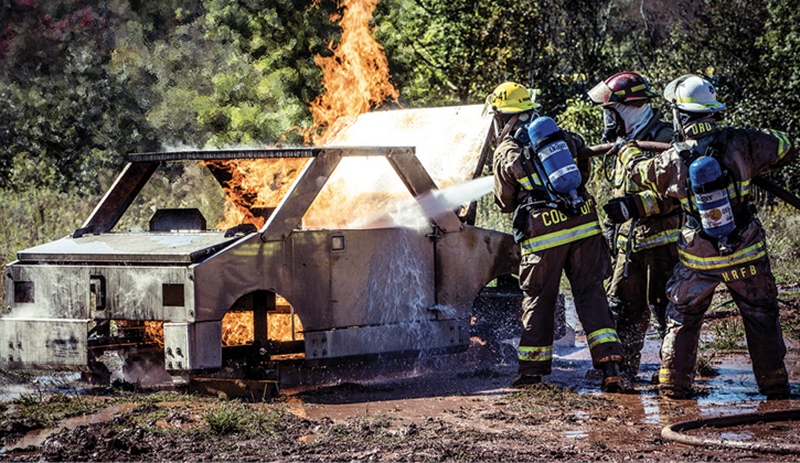Live-Fire Training Paul Tarter
It’s wish season. Fire departments everywhere are preparing for the season, hopeful and listing everything needed.
More than likely as you’re reading this, it’s in the middle of the application period for the U.S. Assistance to Firefighter Grants (AFG) program. For many fire departments, the grant application process is daunting, with lots of data that needs to be collected and questions that need answering. Even after the process, no guarantee exists to ensure that your fire department will be awarded anything.
Before stepping into the grant process, consider these three important factors:
- Is your department currently using outdated equipment beyond the expected life cycle?
- Does your department have a compelling story that will explain why certain equipment is needed?
- Is the request you’re making reasonable?
While there’s a significant amount more to a grant application process, these three factors can be the difference between getting grants and missing out.
Outdated Equipment
The National Fire Protection Association (NFPA) offers a variety of standards for firefighter equipment. Updated on a regular basis, these standards often provide guidelines for how long equipment lasts.
For example, the life cycle of turnouts is eight years, while a self-contained breathing apparatus (SCBA) and cylinder have an expected life of 15 years. Not sure how old your equipment is? The approval labels on the equipment can provide the required information for determining its age.
A side note: If it appears your equipment isn’t lasting that long, questions will arise about proper maintenance as required by the standards. Making sure your department follows regular maintenance schedules with a compliant or certified provider is imperative.
In general, if equipment is outdated—after the expected life cycle, say 20-year-old SCBA or 13-year-old turnouts—that application moves toward the top of the pile if everything else is in order.

1 SCBA, turnouts, and apparatus are the most common grant applications. (Photos courtesy of Drager.)
A Compelling Story
A small fire department begins experiencing a surge of incidents that require specialized equipment—technical rescues, hazardous materials, or something else. Perhaps a firefighter or citizen ended up requiring medical care. With specialized equipment (and proper training), these incidents could be managed better.
Tell that story. Explain why the equipment could have made the difference for the department and everyone involved.
Not a storyteller? Look at the local news coverage. Maybe a friendly reporter or a good writer in the community will help write it up.
Don’t embellish. Tell the story in a straightforward, factual manner.
For example, the firefighter who’s working the pumper might have been overcome from what’s commonly called “smoke inhalation.” However, it could have been much worse. It could be the toxic twins—carbon monoxide (CO) and hydrogen cyanide (HCN). While either by themselves is dangerous or even deadly, the combination of the two is exponentially worse, earning them that distinctive name of the “toxic twins.” Both are colorless, but CO is odorless while HCN has the odor of almonds, although the odor from HCN could be masked by the smoke and other fireground smells. A CO monitor alone will only alert the wearer to increased levels of CO, while HCN remains undetected.
What’s Reasonable?
Let’s say the incident outlined above happens. Is it reasonable to buy the pump operator an SCBA? Or should the department purchase appropriate gas detection devices?
The story will drive that choice. The grant is more likely to be given if the request is seen as reasonable. If the fire department lacks any gas detection, that would be a reasonable first step for the department.

2 Training systems are limited to $50,000 with the Assistance to Firefighter Grant program unless it’s a regional or state organization covering multiple fire departments.
Grant money may seem like a kind of windfall, but it’s often taxpayer money. The committees that make decisions take this responsibility seriously and generally don’t just hand out excessive funds.
When considering an application, start with the basics. For example, the AFG generally awards about $7,500 per SCBA ensemble. However, many ensembles might cost well in excess of $10,000 for the fully outfitted ensemble with add-on technologies.
Many of those add-ons are not approved to their relevant NFPA standard, even though they’re attached to an NFPA-compliant device. Awards will generally never cover equipment that isn’t approved to their relevant NFPA standard. Grants will not be awarded based on what the fire department wants. Instead, the funding is based on fire department needs.
Keeping this in mind, applications should reflect that. While asking for everything might seem like a good strategy—asking for a lot, getting enough—it does increase the chances of getting nothing.
PAUL TARTER has been an active-duty firefighter and an instructor at Texas A&M Engineering Extension (TEEX) for more than 20 years. He’s currently a member of Texas Task Force 1. He is the product manager for First Training Systems at Dräger in Houston, TX.

